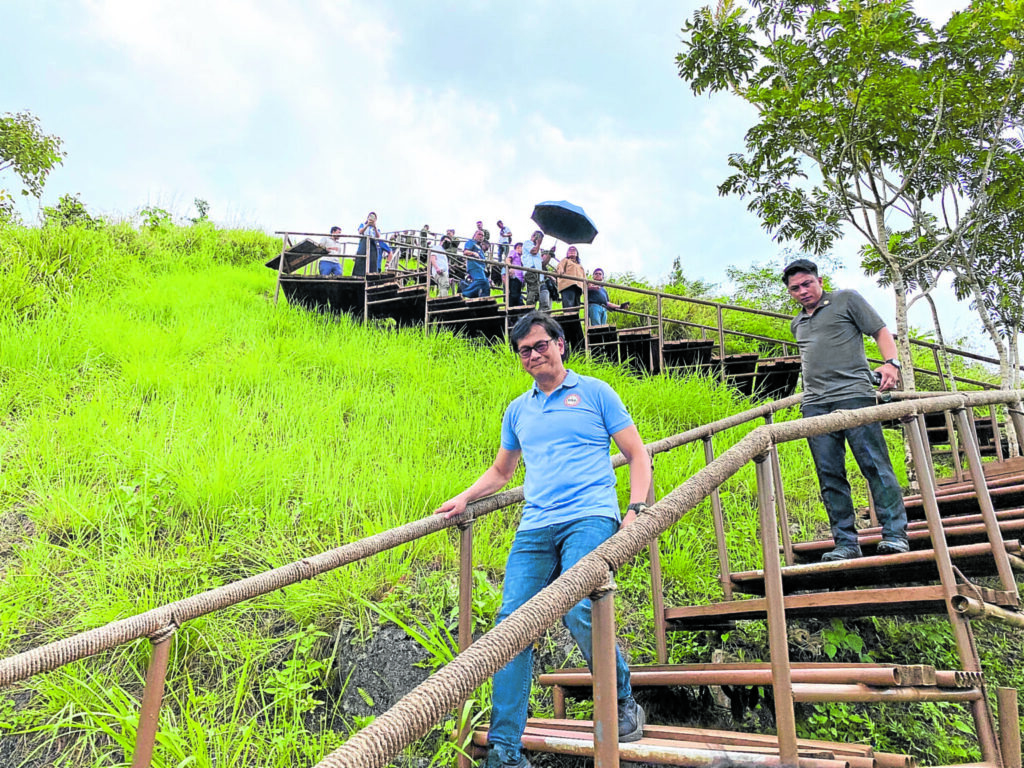
VANTAGE POINT Interior and Local Government Secretary Benhur Abalos, who is part of a government team inspecting illegal structures built within the Chocolate Hills in Bohol on Thursday, climbs a hill through a stairway built at Bud Agta viewing deck in Carmen town. —LEO UDTOHAN
CARMEN, BOHOL — Environment Secretary Maria Antonia Yulo Loyzaga has asserted that illegal structures in the Chocolate Hills must be removed to maintain its status as the first global geopark declared by the United Nations in the country.
She said Bohol must adhere to certain standards for development.
Loyzaga made this statement while inspecting structures, such as the contentious Captain’s Peak Garden and Resort, within the Chocolate Hills. She stressed the need for rehabilitation of such sites to preserve the geopark’s integrity.
She was accompanied by Interior and Local Government Secretary Benhur Abalos, whose separate investigation would look into the culpability of officials who allowed these structures to be built inside a protected landscape.
READ: Bohol governor wants truth in Chocolate Hills development
Abalos and Loyzaga first inspected Captain’s Peak Garden in Barangay Canmano, Sagbayan town.
Inside the resort, they saw a large swimming pool, cottages, and other structures at the foot of the Chocolate Hills, considered a protected landscape under the Expanded National Integrated Areas Protected System (Nipas) Act.
The Chocolate Hills, the top attraction of Bohol, are a geological wonder. The 1,776 mounds, which turn brown during the dry season, are spread over the towns of Bilar, Carmen, Batuan, Sierra Bullones, and Sagbayan.
Records showed that the 10,068 square-meter lot, where Captain’s Peak now stands, was already titled before Edgar Button acquired the property in 2005.
While the resort had no environmental compliance certificate (ECC) from the Department of Environment and Natural Resources (DENR), it was able to secure a business permit from the Sagbayan local government in 2018. It was renewed in January 2024 only to be revoked on March 14 in the wake of the controversy.
INSPECTION Environment Secretary Maria Antonia Yulo Loyzaga (third from left) leads a government team inspecting the Captain’s Peak Garden and Resort in Sagbayan, Bohol, on Thursday. The visit was part of the Department of Environment and Natural Resources’ investigation into the illegal structures within the Chocolate Hills. —LEO UDTOHAN
Disturbance
To rehabilitate the Chocolate Hills, Loyzaga said the structures should be demolished.“Looking at this, it is very possible all of these will have to be demolished and restored because there is a disturbance in the ecology,” said Loyzaga.
According to Loyzaga, the Protected Area Management Board (PAMB), which oversees any development in the Chocolate Hills, should also be strengthened since it is on the frontline of environmental protection.
While PAMB is composed of local officials, it requires some technical capacity in order to manage, decide, and implement development plans, she said.
Abalos said the organizational structure of PAMB should be reviewed for “check and balance.”
Loyzaga said the public should also expect some changes in the applications involving protected areas.
Local environment offices could no longer process applications as these would have to go through the DENR biodiversity bureau before going to the Environmental Management Bureau for processing of the ECC.
For structures built before the Nipas Act was implemented, like the Chocolate Hills Complex in the village of Buenos Aires in Carmen town, Loyzaga said their operators should consider “mitigation hierarchy,” a tool used to limit the damage an action, such as development, would have on the environment. “Let us preserve whatever we have … [A] protected area is [a] protected area,” Abalos said.